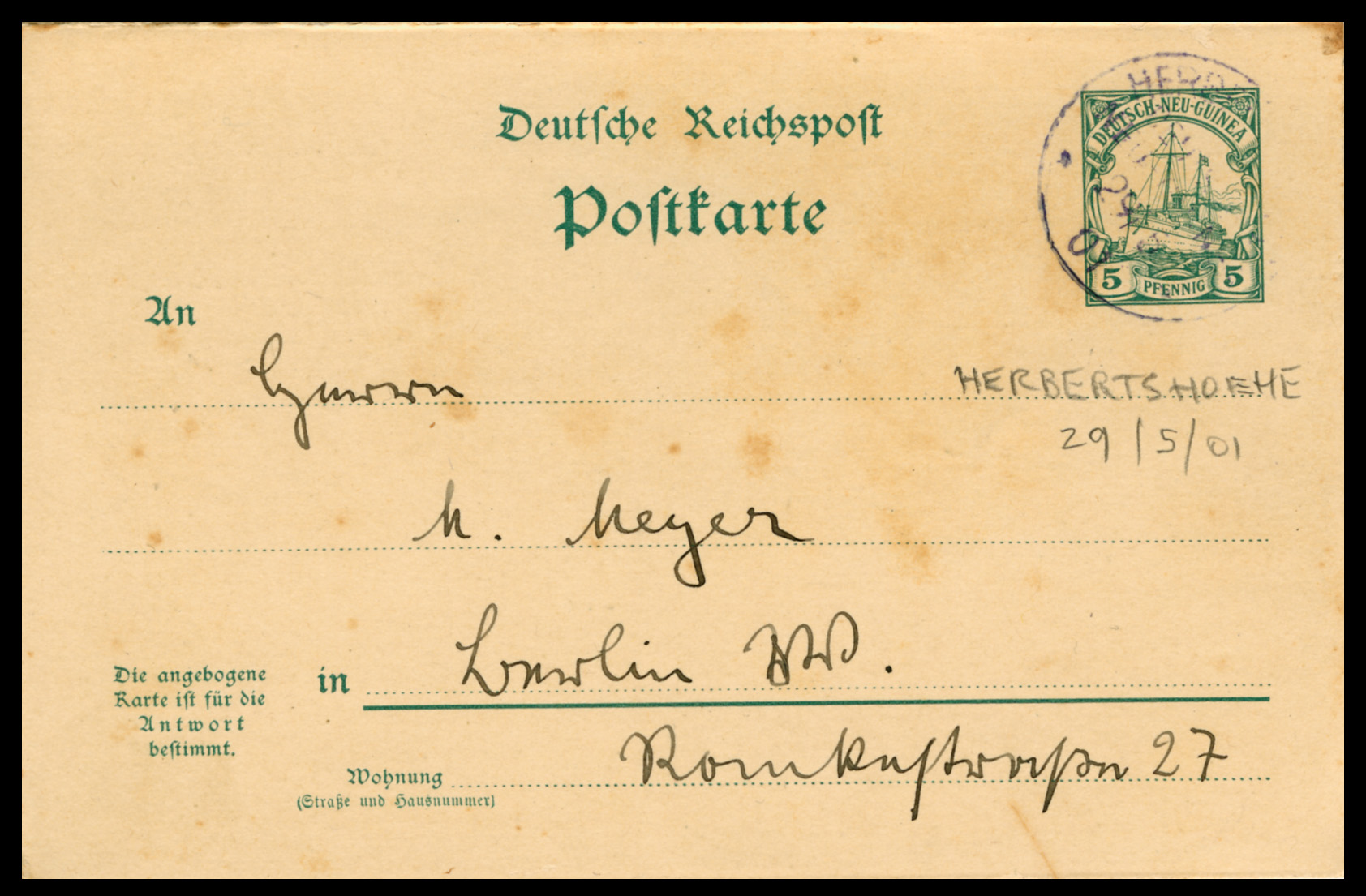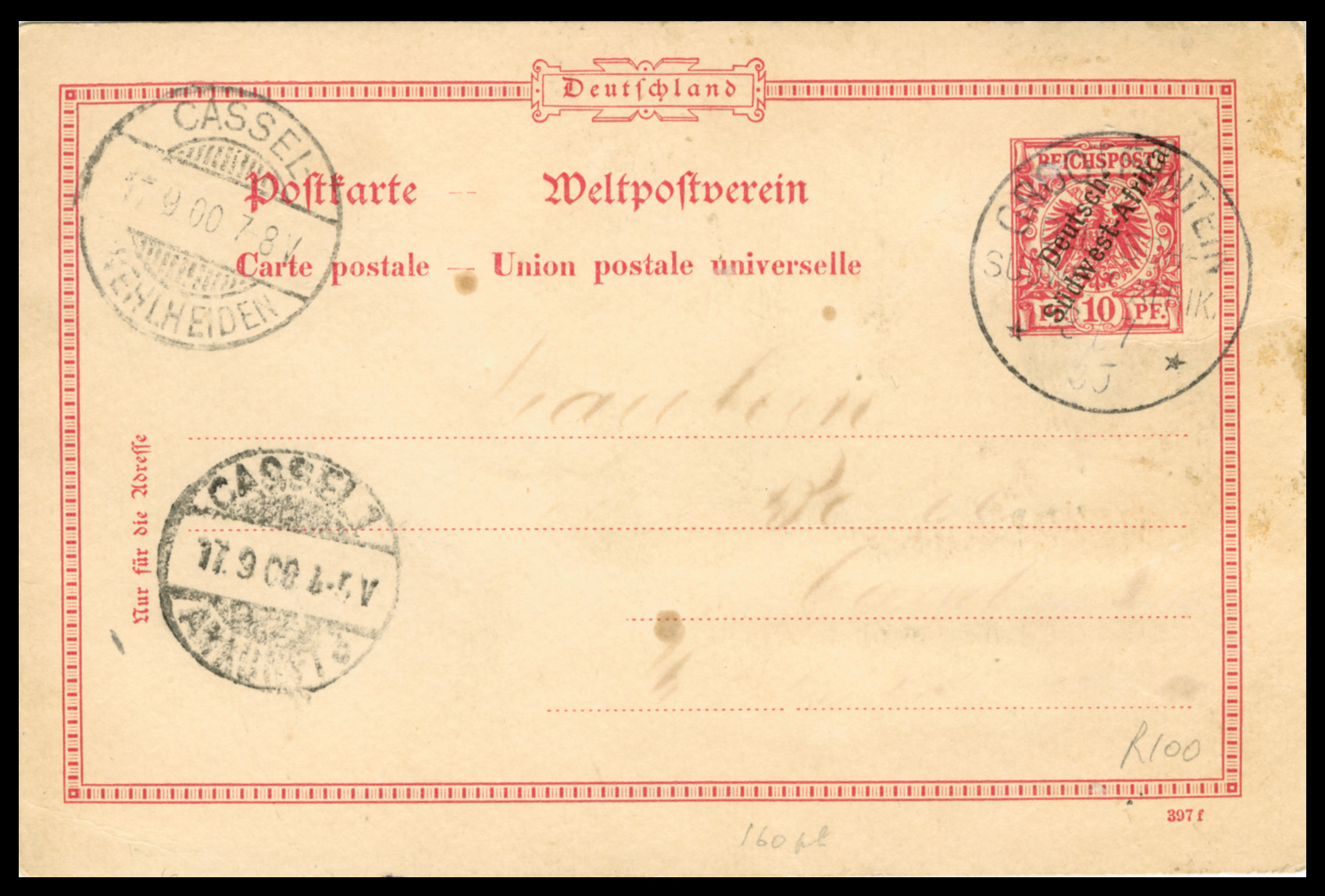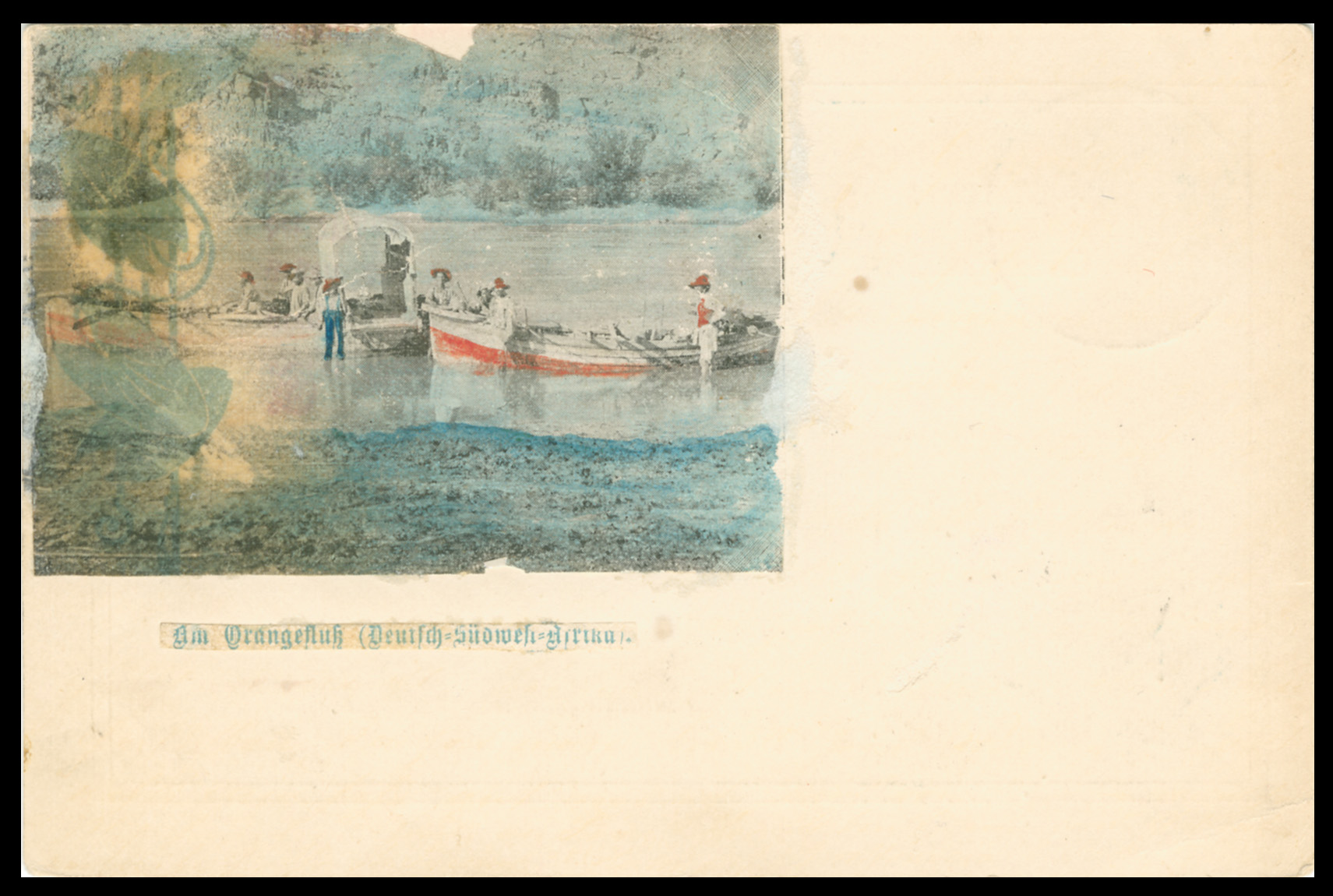THE FAR SIDE OF GERMAN SOUTH WEST AFRICA
Quote from Steve on April 6, 2022, 12:16 pmI recently bought some SWA material at auction. It was described as "SWA small lot of postal history. See scan." It included the postcards below. The 10 Pfg red was included in the scan but the other, a complete two-part 5 Pfg green Reply Card, was not. I assume it was thrown in to the lot to give it the appearance of greater value. It became my Freebie from Hell. Let me share my humiliation with you. There is a philatelic lesson in here somewhere.
At some point in the 5 Pfg green's life someone had written 'Hebron' below the postmark. Perhaps this was a deliberate red (or green) herring but it totally threw me off the scent. It suggested that the postcard came from somewhere it did not and on that basis I proceeded to research 'Hebron SWA'. (The listing "SWA small lot" suggests the auctioneer also imagined a Hebron in SWA.) I suspended my critical facilties and because the postmark was indistinct I looked up 'Hebron' in Putzel's "Comprehensive Handbook of Postmarks of GSWA", all to no avail. There is no 'Hebron' listed anywhere in the book, neither under GSWA nor the Union / Republic period. So, what was going on?
Well, what was going on is that I was being a prize idiot! In my defence, the name 'Hebron' is a Biblical one, as are many other town names in GSWA. This is due to the influence of Rhenish missionaries who preceded German colonisation in Namibia by two generations. I think that is where and how my confusion began. It is a Biblical name that is appropriate to GSWA. It was not until I decided to look at the indistinct postmark under a powerful magnifying glass that I began to doubt it said 'Hebron'. And then I saw it - 'DEUTSCH- NEU-GUINEA'. It was so obvious! It wasn't even a GSWA stamp but one from another German colony north of Australia on the flipside of the world.
The only 'Hebron' I know of is way away to the east in the Biblical Orange Free State, South Africa. I must have made a mental association with it, as did the previous owner / dealer. What a waste of time! A classic case of not looking at a stamp before jumping to conclusions about it. Hebron indeed! I wonder who the previous owner was who wrote that? I imagine it was a casual and genuine mistake by a busy elderly dealer who had misplaced his spectacles. If it was an intentionally cunning ploy, well, I fell for it hook, line and sinker! The lesson is "be wary of the advice of dealers". In this instance one wrote 'Hebron' on the card, another accepted it 'as is' without flagging it up and I, a reasonably knowledgeable collector tripped over the damn thing and fell with my face in the egg.
I have now correctly annotated the Reply Card with 'HERBERTSHOEHE 29 5 01', then a settlement situated on Blanche Bay in the Bismarck Archipelago, New Britain. (What a colonial mouthful! Another island is called New Ireland!) Herbertshohe was the original capital of the Protectorate of German New Guinea until 'first village' status transferred to Rabaul in 1910. Today, Herbertshohe is known as 'Kokopo'. It is about as far as you can get away from the aridity of Namibia. I wonder if this postcard has any value? As a GSWA item with an incomplete 'Hebron' postmark it was probably thought to be worthless, which is why it was thrown into the lot to bulk it up. Or fool someone. Me! Not that I bought the lot for the 'Hebron SWA' item. I didn't even know it was there.
The handwritten address on the second 10 Pfg postcard has faded but this does not detract much from the faint but complete GROOTFONTEIN postmark of '8 7 00'. This was the only datestamp used in Grootfontein between 1899 to 1915. It is not great and will not win you a Gold but it is useful addition to my GSWA display which has finally been updated and will be re-posted on the site soon.
What is of interest in the postcard, to me at any rate, is the printed colour image that has been stuck on the reverse. It appears to be a private attempt to give the blank reverse of the postcard a more topical look. The image is in a poor state but shows two boats and about a dozen men on the Orange River. It may have been stripped off another postcard. It is much faded and worn but like much of postal history it provides a tantalising glimpse into the past, this one an Orange River adventure over 120 years ago. As a boy and young man I had similar outings on South Africa's fresh water rivers and loved every minute spent in them. Those moments still linger as a treasured memory.
The fraudster Lüderitz drowned while exploring the 'Gariep' in 1886 in search of treasure. Desperate to find a source of income from his vast lands he placed himself in charge of a second expedition down the Orange River. Two small boats were transported via Aus and Bethanie to Nabasdrift, close to the confluence of the Fish and Orange Rivers from where the party travelled downstream towards Oranjemund and the Atlantic Ocean. Lüderitz's boat was lost and his body never found. His last reported overnight stay was on 21/22 October 1886. His body was presumably washed downriver and eventually out to sea. Ironically, his final journey would have taken him past the world's most profitable onshore and offshore diamond fields that then lay undiscovered. I wonder if diamonds lying in the bed of the flowing river helped grind his mortal remains down to primordial ooze and slime. Whatever.... Lüderitz sleeps with the fish!
I recently bought some SWA material at auction. It was described as "SWA small lot of postal history. See scan." It included the postcards below. The 10 Pfg red was included in the scan but the other, a complete two-part 5 Pfg green Reply Card, was not. I assume it was thrown in to the lot to give it the appearance of greater value. It became my Freebie from Hell. Let me share my humiliation with you. There is a philatelic lesson in here somewhere.
At some point in the 5 Pfg green's life someone had written 'Hebron' below the postmark. Perhaps this was a deliberate red (or green) herring but it totally threw me off the scent. It suggested that the postcard came from somewhere it did not and on that basis I proceeded to research 'Hebron SWA'. (The listing "SWA small lot" suggests the auctioneer also imagined a Hebron in SWA.) I suspended my critical facilties and because the postmark was indistinct I looked up 'Hebron' in Putzel's "Comprehensive Handbook of Postmarks of GSWA", all to no avail. There is no 'Hebron' listed anywhere in the book, neither under GSWA nor the Union / Republic period. So, what was going on?
Well, what was going on is that I was being a prize idiot! In my defence, the name 'Hebron' is a Biblical one, as are many other town names in GSWA. This is due to the influence of Rhenish missionaries who preceded German colonisation in Namibia by two generations. I think that is where and how my confusion began. It is a Biblical name that is appropriate to GSWA. It was not until I decided to look at the indistinct postmark under a powerful magnifying glass that I began to doubt it said 'Hebron'. And then I saw it - 'DEUTSCH- NEU-GUINEA'. It was so obvious! It wasn't even a GSWA stamp but one from another German colony north of Australia on the flipside of the world.
The only 'Hebron' I know of is way away to the east in the Biblical Orange Free State, South Africa. I must have made a mental association with it, as did the previous owner / dealer. What a waste of time! A classic case of not looking at a stamp before jumping to conclusions about it. Hebron indeed! I wonder who the previous owner was who wrote that? I imagine it was a casual and genuine mistake by a busy elderly dealer who had misplaced his spectacles. If it was an intentionally cunning ploy, well, I fell for it hook, line and sinker! The lesson is "be wary of the advice of dealers". In this instance one wrote 'Hebron' on the card, another accepted it 'as is' without flagging it up and I, a reasonably knowledgeable collector tripped over the damn thing and fell with my face in the egg.
I have now correctly annotated the Reply Card with 'HERBERTSHOEHE 29 5 01', then a settlement situated on Blanche Bay in the Bismarck Archipelago, New Britain. (What a colonial mouthful! Another island is called New Ireland!) Herbertshohe was the original capital of the Protectorate of German New Guinea until 'first village' status transferred to Rabaul in 1910. Today, Herbertshohe is known as 'Kokopo'. It is about as far as you can get away from the aridity of Namibia. I wonder if this postcard has any value? As a GSWA item with an incomplete 'Hebron' postmark it was probably thought to be worthless, which is why it was thrown into the lot to bulk it up. Or fool someone. Me! Not that I bought the lot for the 'Hebron SWA' item. I didn't even know it was there.
The handwritten address on the second 10 Pfg postcard has faded but this does not detract much from the faint but complete GROOTFONTEIN postmark of '8 7 00'. This was the only datestamp used in Grootfontein between 1899 to 1915. It is not great and will not win you a Gold but it is useful addition to my GSWA display which has finally been updated and will be re-posted on the site soon.
What is of interest in the postcard, to me at any rate, is the printed colour image that has been stuck on the reverse. It appears to be a private attempt to give the blank reverse of the postcard a more topical look. The image is in a poor state but shows two boats and about a dozen men on the Orange River. It may have been stripped off another postcard. It is much faded and worn but like much of postal history it provides a tantalising glimpse into the past, this one an Orange River adventure over 120 years ago. As a boy and young man I had similar outings on South Africa's fresh water rivers and loved every minute spent in them. Those moments still linger as a treasured memory.
The fraudster Lüderitz drowned while exploring the 'Gariep' in 1886 in search of treasure. Desperate to find a source of income from his vast lands he placed himself in charge of a second expedition down the Orange River. Two small boats were transported via Aus and Bethanie to Nabasdrift, close to the confluence of the Fish and Orange Rivers from where the party travelled downstream towards Oranjemund and the Atlantic Ocean. Lüderitz's boat was lost and his body never found. His last reported overnight stay was on 21/22 October 1886. His body was presumably washed downriver and eventually out to sea. Ironically, his final journey would have taken him past the world's most profitable onshore and offshore diamond fields that then lay undiscovered. I wonder if diamonds lying in the bed of the flowing river helped grind his mortal remains down to primordial ooze and slime. Whatever.... Lüderitz sleeps with the fish!
Uploaded files:


